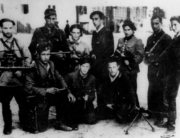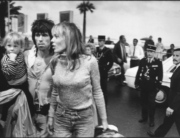![]() Following behind the footsteps of Orson Welles, Morgan Neville’s documentary acts as the perfect precursor to Welles’s infamous, long in the making film, The Other Side of Wind. The two films seamlessly blend together to concoct a touching portrait of the great filmmaker and coexist symbiotically, making for a delightful double bill. (Seeing Neville’s film first will likely enhance the viewing of the feature film.) Both launched on Netflix on November 2.
Following behind the footsteps of Orson Welles, Morgan Neville’s documentary acts as the perfect precursor to Welles’s infamous, long in the making film, The Other Side of Wind. The two films seamlessly blend together to concoct a touching portrait of the great filmmaker and coexist symbiotically, making for a delightful double bill. (Seeing Neville’s film first will likely enhance the viewing of the feature film.) Both launched on Netflix on November 2.
The enigmatic figure of Welles as an artist, who constantly sought to elevate film in all manners, is a portrait well depicted in previous features. (Cut from the same cloth as Neville’s film, Mark Cousin’s recent The Eyes of Orson Welles comparably highlights Welles as a master painter and sketch artist and how that influenced his films.) Onscreen narrator Alan Cumming, is a welcomed presence here, an entry point into the frenzied world in which The Other Side of the Wind was made in the early to mid-1970s.
Once Cumming’s fourth-wall breaking presence is established, Neville sets about deconstructing the methods of filmmaking deployed by Welles. Through John Houston, Welles portrays a stand-in for himself on screen. In casting Houston, the differing lengths each director/actor went about in their careers, with the resulting media reception, is inherently contrasted. Morgan also touches upon the influences of Wind‘s film within the film—from European art films of the ’60’s and ’70’s by the likes of Jacques Demy, Michelangelo Antonioni, and Ingmar Bergman—which adds a deeper nuance to the actual film, such as the fact that Welles used the house located next to one that was blown up in Antonioni’s Zabriskie Point as the central setting for Wind.
An array of talking heads paint shades of grey on the portrait of Welles. (Many of those speaking are not identified until the closing credits, which don’t quite clarify who’s who.) The interviews provide a bittersweet context that broadens Neville’s film as more than a making-of documentary. The appearance of filmmaker and Welles biographer Peter Bogdanovich and Tony Houston, the director’s son, ground the discussion emotionally, particularly when focusing on Bogdanovich’s personal relationship with Welles, who, for a time, lived with Bogdanovich and Cybill Shepherd. Bogdanovich also outlines their public falling out and his first-hand accounts of the financial, personal, and legal lengths Welles went through to complete Wind.
Besides this documentary, other works that highlight the peculiar nature of filmmaking is reflected in the book When The Shooting Stops…The Cutting Begins: A Film Editor’s Story by Ralph Rosenblum and Rob Karen and the podcast You Must Remember This. The eclectic presence of footage from Touch of Evil, among other films by Welles, will titillate viewers to further absorb themselves in the work of the filmmaker.
A great exploration of a pivotal director, They’ll Love Me When I’m Dead suggests that there is most definitely a method to the madness of Welles’s filmmaking.
Directed by Morgan Neville
Released by Netflix
USA. 98 min. Not rated







Leave A Comment